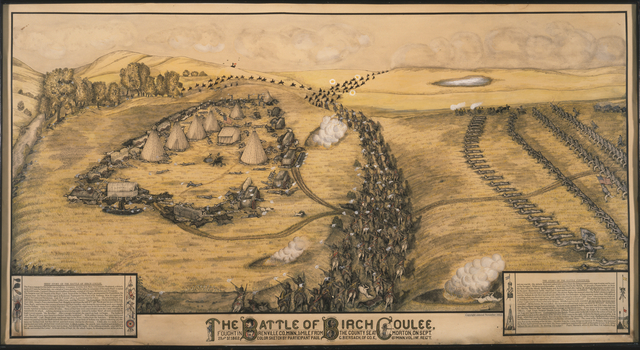The US-Dakota War of 1862
We’re grateful to have another group of blog posts written by student volunteers through Wayzata High School’s Club Y.E.S. program. This week’s post is by Raksha Shankar.

The War of 1862 was a tragic war that demonstrates the complicated legacy of the US land treaty system. Between 1805 and 1858, treaties made between the U.S. government and the Dakota nation reduced Dakota lands and significantly altered Minnesota’s physical, cultural, and political landscape. These treaties put a big strain on future Dakota-U.S. government
relations. The Dakota felt cheated because large portions of the annuity money promised to the Dakota in exchange for land were given to traders instead, who claimed debts were owed by the Dakota. By result, the Dakota became hungry and desperate. On Aug. 18, 1862, a group of Dakota began attacking trading posts and settlements along the Minnesota River Valley. This event sparked the beginning of the U.S.-Dakota War of 1862.
In response, on Aug. 20, 1862, Col. Sibley and the 6th Minnesota Infantry, a hastily-formed regiment made up of local volunteers and army troops, marched from Fort Snelling towards the town of St. Peter. After waiting for supplies and reinforcements, Sibley and his forces advanced towards Fort Ridgely. While at the fort, Sibley sent out a burial party to locate and bury the remains of civilians. In a turn of events, the burial party was attacked by Dakota soldiers at Birch Coulee on Sept. 2, 1862. When reports of the attack reached Fort Ridgely, Sibley immediately left to fight with the remainder of his force. Later on, the Dakota withdrew from the battle, and Sibley and his troops returned to Fort Ridgely to continue their training.
Sibley tried to negotiate a settlement with Taoyateduta or Little crow the third, chief of the Dakota tribe, but Taoyateduta did not agree to stop the fighting. As Taoyateduta refused again to surrender, Sibley and his troops moved up the Minnesota River, arriving at Lone Tree Lake (mistakenly identified as Wood Lake), where they camped on Sept. 22. In the morning several soldiers from the newly arrived 3rd Minnesota Infantry left camp and stumbled upon a group of Dakota soldiers that had been preparing to attack Sibley’s forces. The ensuing Battle of Wood Lake on Sept. 23, 1862 was the last major battle, resulting in defeat for the Dakota. The U.S.-Dakota War of 1862 began in anger and ended in tragedy.